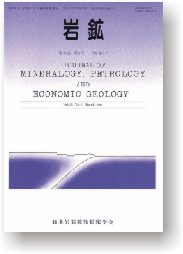All issues

Volume 91, Issue 12
December
Displaying 1-3 of 3 articles from this issue
- |<
- <
- 1
- >
- >|
ORIGINAL ARTICLES
-
Yoshihiko GOTO1996 Volume 91 Issue 12 Pages 427-442
Published: 1996
Released on J-STAGE: October 28, 2006
JOURNAL FREE ACCESSThe Oshinkoshin Intrusion is a mushroom-shaped, basaltic andesite intrusion of Pliocene age that occurs in the Shiretoko Peninsula, Hokkaido, Japan. The intrusion is 1000 m long and 400 m wide and consists of three concentric zones: inner massive zone, polyhedral jointed zone, and marginal banded zone. The inner massive zone occupies the central part of the intrusion, and is characterized by columnar joints 100 to 250 cm across. The polyhedral jointed zone encircles the inner massive zone, and is characterized by columnar joints 70 to 150 cm across and small polyhedral joints. The small joints outline 10 to 25 cm polyhedra on both longitudinal and transverse surfaces of the columns. The marginal banded zone encircles the polyhedral jointed zone, and shows rhythmic banding parallel to the margins and columnar joints perpendicular to the margins. The rhythmic banding is composed of alternating protruding, more weathering-resistant and recessive, less resistant bands, both of which are a few centimetres thick. Each protruding band characteristically encloses a central vein. Chemically, protruding bands have higher SiO2 and K2O and lower MgO and total Fe contents than recessive bands. Veins in the protruding band have much higher SiO2, TiO2, Na2O, K2O, P2O5, and lower Al2O3, MgO, CaO than the protruding band. The thicknesses of the protruding and recessive bands gradually decrease toward the margin of the intrusion. The concentric zonal structure in the Oshinkoshin Intrusion formed by cooling of a magma which was emplaced in a single intrusive phase into wet, poorly consolidated sediment. The rhythmic banding in the marginal banded zone formed by concentration of residual melt in numerous parallel cooling fractures along the margin of the intrusion, as the rheological behavior of magma changed from ductile to brittle.View full abstractDownload PDF (6381K) -
Structural features of granulites from Rayagada, Eastern Ghats, India: some preliminary observationsR.K. SHAW1996 Volume 91 Issue 12 Pages 443-454
Published: 1996
Released on J-STAGE: October 28, 2006
JOURNAL FREE ACCESSA suite of granulates including metasedimentary rocks (khondalite, quartzite and calc-silicate granulite), mafic granulite, orthopyroxene granulite, and garnetiferous granite gneisses (leptynite, sillimanite granite and porphyritic granite) exposes in the Rayagada area, north-central part of Eastern Ghats Granulite Belt of Peninsular India. Among these, important marker horizons like calc-silicate granulate and quartzite have been used to establish the sequence and geometry of folds on a regional scale. Signatures of three phases of deformations (D1, D2, D3 from the earliest to the latest) are present in metasedimentary rocks and mafic granulite, whereas most of the massive orthopyroxene granulite, leptynite and sillimanite granite exhibit foliation corresponding to the second deformation event. These three deformations correspond to three folding episodes: F1 (intrafolial fold), F2 (tight to isoclinal fold) and F3 (open fold) respectively. Axial surfaces of F1 and F2 are mostly parallel, trending NNE-SSW and F3 axial plane is at right angle to that of F1 and F2 folds. Corresponding axial plane foliations are gneissic banding in khondalite and mafic granulate (S1), a pervasive foliation in granite gneiss (S2) and a sporadic fracture cleavage in all the rock-types (S3). In most cases, structures of first deformation (D1) were superimposed by the second one (D2), resulting D2 structures (both folding and foliation) as the dominantly preserved deformation structure. D1 deformation and D2 deformation have been inferred to be related to the E-W or ESE-WNW directed compression and progressive simple shear and D3 deformation might be related to the strike-slip displacement and NNE-SSW transtension.View full abstractDownload PDF (4004K) -
Kiminori SATO, Kosuke ONUMA, Eiji OHTANI, Takumi KATO1996 Volume 91 Issue 12 Pages 455-458
Published: 1996
Released on J-STAGE: October 28, 2006
JOURNAL FREE ACCESSA high-titanium containing garnet, SiO2(40.6), TiO2(6.3), Al2O3(18.8), MgO(14.3), CaO(20.21), (wt%) has been synthesized at 10 GPa and 1500°C. Unit cell parameter of this synthetic garnet is determined to be 11.812 Å by micro-focused X-ray diffractmetry and this value is intermediate between those of pyrope and grossular. These results indicate that pyrope-grossular garnet potentially can accommodate TiO2 up to 6.3 wt% at the high of 10 GPa.View full abstractDownload PDF (413K)
- |<
- <
- 1
- >
- >|